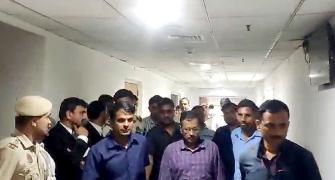'We want to make sustainability affordable.'
'We tell everyone, don't just recycle, Craste it!'

Crop burning in Punjab and Haryana and the subsequent rise in air pollution in Delhi and its surrounding areas have been gaining international attention every year.
In November 2023, when the air quality in Delhi and its surrounding areas reached 'hazardous' levels, the Supreme court of India directed the authorities of Punjab and Haryana, to stop farmers from burning agricultural waste.
According to the government air-quality monitoring agency SAFAR, stubble burning in Punjab and Haryana accounts for 30 per cent to 40 per cent of air pollution in Delhi in October-November.
Reports say, India produces around 500 million metric tonnes (MT) of crop waste annually, and burns about 100 MT of it. This is more than the entire agricultural waste production of the other Asian countries like Bangladesh, Indonesia, and Myanmar.
Why do farmers burn crop waste? It is to prepare the field for the next crop, and stubble burning is the cheapest and easiest way to clear the waste.
Is there any other alternative to crop waste burning? Is there any way we can make use of crop waste?
Yes, Craste, the start-up founded by two siblings -- Shubham Singh and his elder sister Dr Himansha Singh from Morena in Madhya Pradesh -- has a win-win solution for both farmers and environment.
"We want farmers as the stakeholders. We want them to take the technology from us and become pulp manufacturers themselves. We want the plants to be operated by the farmers, for the farmers," Dr Himansha Singh tells Shobha Warrier/Rediff.com.

It all began when in school
We grew up in a small village near Gwalior called Morena. Though our parents did not get higher education, they made sure that both my brother and I studied as much as we wanted.
We took our first steps as entrepreneurs when we were teenagers and in school. We started an NGO to provide education to the kids in the rural areas. We named it Gramiksha (external link), that is, giving shiksha to the students in 'gram' (villages).
The idea of doing something for society was instilled in us by our parents and grandparents from when we were very small.
It was an organisation started by students, for students. We began by going to the government schools to help the students in what they wanted, and not what we wanted. We found out earlier itself that every school in every village is different and their needs are different.
It was by running Gramiksha that we learnt managerial skills which helped us later on in life.
When we started Gramiksha, we did not expect it to grow so big. Today, we have 950 plus volunteers working in six cities in more than 30 schools.
As the NGO grew, both of us took a back seat, and created a national team to take care of the functioning of Gramiksha.
Taking wings and going to the UK for higher studies
In 2010, I moved to the UK to study at the University of Manchester. Later on, I did my doctorate and post-Doc at Cambridge in Pharmacology on BBSRC Discovery Fellowship.
My brother also came to the UK to study chemical engineering at Imperial College.
As Cambridge was very strong in inspiring fellows to take scientific innovations to commercial stage, I would say it was there that my entrepreneurial journey really started.

Come October, November, and it's all about crop burning in India on BBC
Though farmers burn crops everywhere, what happens in India made headlines globally. It's also because of the scale at which it is done.
Not just in India but in Indonesia and Thailand also, crop burning is a huge issue. The difference between other European or western countries is, they don't grow rice and wheat at the level India or Indonesia grows. For example, in the US, there is more of corn farming than rice or wheat.
You may know, India is the largest producer of rice and wheat in the world!
Because Shubham is a chemical engineer, he used to talk to me about what could be done to stop crop waste from burning.
The question was, when bagasse (a dry and raw by-product of sugarcane waste) can be used to make paper, why can't we do the same with rice and wheat crop waste?
Yes, there are machines like the agricultural shredder to clear crop waste but then hiring a machine is expensive for the small Indian farmer.

Shubham comes back to India first to find a solution to crop burning
Because Shubham had this idea to work in the field of agri-waste, he moved back to India first, and pitched his idea to the Government of India.
He won the SoCH innovation challenge award that is given to entrepreneurs who work in the field of community health. Under the fellowship, he travelled to rural India to hear directly from the farmers the problems they face. He felt that way, he could come up with the right solution.
One solution, he came up with was to use agricultural waste to produce biodegradable packaging which could replace plastic. This way, you can stop crop burning and also reduce the use of plastic.
When we spoke to the farmers, we realised that they were acutely aware of the problem crop burning creates. But then they have no other viable alternative available.
They are more conscious and concerned about the environment than those who lectures on protecting the environment.
They have a valid point when they asked us, you have only problem with us burning the crop once a year. What about the carbon emission from vehicles and industries in the cities?
It is easy to preach in an utopian world but it doesn't work in the real world as these farmers have to work and make money to have their daily meal.
We asked them, what if you get money from the waste?
They were only willing to sell us the waste as they were going to get a secondary income.

And Craste is born to take care of 'crop' 'waste'
With all the data Shubham collected, we decided to start an R&D centre to come up with the right solution to convert agricultural waste to biodegradable packaging.
That was when I also got fully involved in the idea even though I was in the last stages of my post-doc.
In 2018, we officially started Craste.
With the idea, we applied for the BIRAC funding from the government of India.
The first major funding we got was from BIRAC, and we started our R&D lab with a team of five scientists in Pune with Onkar Siddheswar, our founding team member as the head of engineering.
With our major funding coming from the government of India, we incubated at the Venture Center in Pune. It was at the Venture Center that we learnt how to commercialise the idea, how to apply for a patent, etc.
We also got an equity-free grant which was also put in our lab.
Finally, it was more like setting up a lab than starting a company.

Within a year, Craste was in the list of global top 10 start-ups in sustainability
Because of the presence of silica in rice waste, it was not used in manufacturing anywhere. So, what we were trying to come up in the lab was, how to use rice waste in manufacturing something.
Our research in the lab was to find a new process in converting rice waste into paper.
The technology we came up with uses only one third of water that is used in the conventional process of converting rice waste into paper.
The effluent from our plant is also negligible. It is to showcase this that we put up our first plant in the middle of a mustard farm in Morena. We wouldn't have set up the plant in a field unless it is environment friendly.
In 2019, we were listed in the global top 10 start-ups in sustainability. We also became a part of the well-known accelerator in the United States, Techstars. On the invitation of Techstars, both Shubham and I spent three months in the US while our team continued the research at the Venture Center in Pune.
Techstars provide us with mentors from big companies who helped us understand marketing, branding, etc.
As we were going great guns, the pandemic struck and affected our work very badly.
Aim is not just stopping crop burning but stop plastic packaging too
Because of the pandemic, it took us four years finally to get a patent for our technology.
Though we started our research to find a solution to rice crop burning, the technology we have come up with can convert all agricultural wastes, like barley, millet, cotton and even sanitary pad waste into biodegradable pulp. We can make paper out of all these waste.
In order to reduce carbon footprint, we set up our plants very close to farms so that we can easily move the crop waste to the plant.
Our first pilot plant is near Morena.
We want farmers as the stakeholders. We want them to take the technology from us and become pulp manufacturers themselves. We want the plants to be operated by the farmers, for the farmers.

Handmade paper and packaging from waste
Even from the small amount of waste we convert to pulp in our factory, we have started manufacturing handmade paper and packaging.
Our clients are many major MNCs. For example, Nestle wanted wheat packaging for their wheat cereal.
We also provide R&D as a service which is one of our revenue models.

Green board for furniture too from waste
We have also made India's first formaldehyde-free, and hundred per cent tree-free board from crop waste. As you know formaldehyde is known as a 'human carcinogen'.
A study conducted by the International Union of Forest Research Organizations, India ranks third in the world in importing timber illegally.
This is where our Engineered Green Boards becomes important as they are developed only from crop waste and not trees.
Other than saving trees, we are saving carbon emission too. For example, when you buy one of our engineered green board, you are saving as much as 30kg of Co2 emissions which otherwise would have been released from crop waste burning.
Our second patent is for the blender we have designed to make our Engineered Green Boards.

Plans for the future
We want to license our technology so that others can also set up factories wherever there are farms. This is the only way to stop crop burning.
In the farm where we have our factory, and in the areas that are at least 40-50 km away also, there was no crop burning because we bought all the crop waste from them.
We want to make sustainability affordable.
We tell everyone, don't just recycle, Craste it! We want Craste to be the symbol of moving to a sustainable, compostable, tree-free and plastic-free world.
Feature Presentation: Ashish Narsale/Rediff.com









